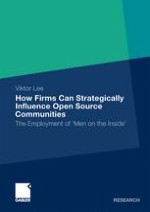2012 | OriginalPaper | Buchkapitel
Results
verfasst von : Viktor Lee
Erschienen in: How Firms Can Strategically Influence Open Source Communities
Verlag: Gabler Verlag
Aktivieren Sie unsere intelligente Suche, um passende Fachinhalte oder Patente zu finden.
Wählen Sie Textabschnitte aus um mit Künstlicher Intelligenz passenden Patente zu finden. powered by
Markieren Sie Textabschnitte, um KI-gestützt weitere passende Inhalte zu finden. powered by
When Dahlander and Wallin introduced the MOI in 2006, they investigated the GNOME
30
project which has been founded by Miguel de Icaza in 1996. The reason why GNOME was founded was that the Norwegian firm Trolltech, the provider of K desktop environment software (KDE), refused to adjust their license according to open source norms (Dahlander and Wallin, 2006). That was the motivation of de Icaza to create a neutral platform which would run under the open source-compliant General Public License (GPL) and thus be available for anyone to use and participate in the development of the software. As de Icaza, or “Miguel” as he was called in the hacker community, was an eminently respectable protagonist in the open source movement prior the foundation of GNOME, he was able to gather a critical mass of talented programmers around him to make the project a success. Quickly, leading firms in GNU/Linux and UNIX, such as RedHat, Sun or Novell, decided to sponsor developer teams and monetary resources to support the platform. GNOME is a desktop environment which runs on top of various operating systems with the main goal “to create a free collection of libraries and applications [to] make Linux a viable alternative” (German, 2003: 202). The GNOME community is composed of “volunteers that are outside the hierarchical realm of firms […] [who] receive no direct financial compensation” (Dahlander and Wallin, 2006: 1248), the so-called hobbyists, as well as community members being employed by firms to participate in the community. The organization of GNOME is built on four pillars that are constructed to be democratic and to make sure that no corporate side can take over the control over the community. Firstly, all members who have contributed non-trivial parts of the product such as code or translations can apply for a membership. The membership needs to be renewed every two years. Secondly, the board of directors will be elected with the constraint that not more than four out of eleven board members come from one single firm. In addition corporate board members must not serve as a “representative[…] of their employers” (German, 2003: 204). The advisory board as the third organizational component is composed of corporate and non-profit organization participants who need to pay an annual fee in order to be accepted. Finally, an executive director is completely sponsored by the community to run the operational management of the project. The GNOME project is quite unique in its organization, involving heavily corporate participants in the community. However, GNOME is not a firm with the goal to make money out of the project but rather strongly emphasizes its history and open source philosophy as its key drivers.
